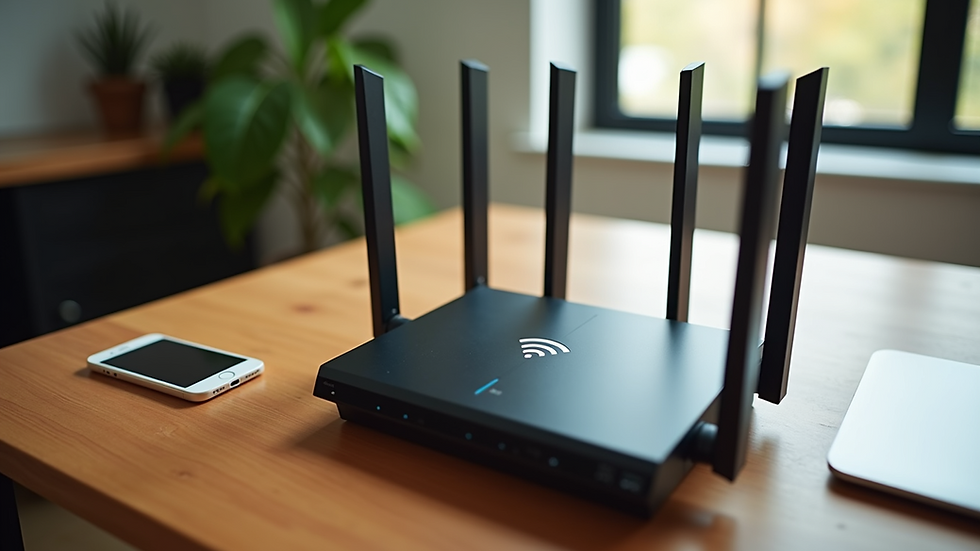Common Network Issues and How to Resolve Them
- Carmella Wright
- Aug 14
- 3 min read
Updated: Aug 25
In today’s connected world, network issues can disrupt work, entertainment, and communication. Understanding common network problems and how to fix them is essential for maintaining smooth internet and intranet connections. This guide covers typical network issues, practical solutions, and a structured approach to network troubleshooting.
Identifying Common Network Issues
Network problems can arise from various sources, including hardware failures, software misconfigurations, or external factors like service outages. Recognizing the symptoms early helps in applying the right fix quickly.
Slow Internet Speeds
Slow internet is one of the most frequent complaints. It can be caused by:
Bandwidth congestion due to multiple devices using the network simultaneously.
Outdated or malfunctioning routers.
Interference from other wireless devices.
ISP throttling or outages.
How to fix it:
Restart your router and modem.
Limit the number of devices connected.
Move closer to the router or use a wired connection.
Check with your ISP for any service issues.
Intermittent Connectivity
When your connection drops randomly, it can be frustrating. Causes include:
Loose or damaged cables.
Router overheating.
Firmware bugs.
Wireless interference.
How to fix it:
Inspect and replace cables if needed.
Ensure the router is in a well-ventilated area.
Update router firmware.
Change the Wi-Fi channel to avoid interference.
IP Address Conflicts
If two devices on the same network have the same IP address, connectivity issues occur.
How to fix it:
Restart devices to obtain new IP addresses.
Assign static IP addresses carefully.
Use DHCP settings on the router to manage IP assignments.

Effective Network Troubleshooting Techniques
Network troubleshooting involves systematic steps to diagnose and resolve issues. Using a methodical approach saves time and prevents guesswork.
Basic Troubleshooting Steps
Check physical connections: Ensure cables and devices are properly connected.
Restart devices: Power cycle routers, modems, and affected devices.
Verify network settings: Confirm IP addresses, DNS settings, and Wi-Fi passwords.
Test with different devices: Determine if the problem is device-specific.
Run diagnostic tools: Use built-in network troubleshooters or command-line tools like ping and tracert.
Update software and firmware: Keep devices up to date.
Contact ISP: If the problem persists, check for outages or account issues.
Using Diagnostic Tools
Ping: Tests connectivity to a server or device.
Tracert/Traceroute: Shows the path data takes to reach a destination.
IPConfig/ifconfig: Displays network configuration details.
Speed tests: Measure internet speed to identify slowdowns.
These tools provide valuable insights into where the problem lies.

What are the 7 steps of network troubleshooting?
Following a structured process helps resolve network issues efficiently. The seven steps are:
Identify the problem: Gather information about the symptoms and scope.
Establish a theory of probable cause: Based on symptoms, hypothesize what might be wrong.
Test the theory: Verify if the suspected cause is correct.
Establish a plan of action: Decide how to fix the issue.
Implement the solution: Apply the fix carefully.
Verify full system functionality: Check if the problem is resolved and the network is stable.
Document findings: Record the issue and solution for future reference.
This approach minimizes downtime and improves troubleshooting skills over time.
Resolving Wireless Network Issues
Wireless networks are convenient but prone to specific problems. Here are common wireless issues and how to address them:
Weak Wi-Fi Signal
Walls, furniture, and electronic devices can weaken Wi-Fi signals.
Solutions:
Place the router in a central, elevated location.
Use Wi-Fi extenders or mesh networks.
Switch to less congested frequency bands (e.g., 5 GHz).
Authentication Failures
Incorrect passwords or security settings can prevent devices from connecting.
Solutions:
Double-check Wi-Fi passwords.
Reset network settings on devices.
Update router security protocols (WPA3 recommended).
Network Not Showing Up
Sometimes, the Wi-Fi network does not appear on devices.
Solutions:
Ensure SSID broadcast is enabled on the router.
Restart the router.
Update device wireless drivers.

When to Seek Professional Help
While many network issues can be resolved with basic troubleshooting, some problems require expert assistance. Consider professional help if:
Network outages persist despite all troubleshooting.
You suspect hardware failure.
Complex configurations like VPNs or firewalls are involved.
Security breaches or malware infections are suspected.
For detailed guidance and support, resources like troubleshooting network connectivity offer valuable help.
Enhancing Network Reliability
Preventing network issues is better than fixing them. Here are tips to improve network stability:
Regularly update firmware and software.
Use quality networking hardware.
Secure your network with strong passwords and encryption.
Monitor network performance with tools and alerts.
Schedule periodic network audits.
By maintaining your network proactively, you reduce the chances of unexpected disruptions.
Mastering network troubleshooting empowers you to handle common issues confidently. Whether it’s slow speeds, connectivity drops, or configuration errors, a systematic approach and practical solutions keep your network running smoothly. For ongoing support and advanced troubleshooting, always have reliable resources at hand.




Comments